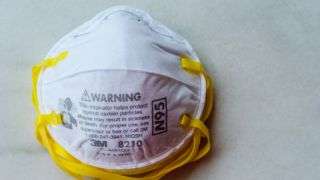
All about COVID-19

—See live updates on the new coronavirus
—How deadly is COVID-19?
—How does the new coronavirus compare with flu?
—Why are children ‘missing’ from coronavirus outbreak?
A certain type of respirator effectively protects medical workers from catching COVID-19, the viral disease that has sickened more than 75,000 people since December 2019.
Caused by the newfound coronavirus SARS-CoV-2, COVID-19 can spread to new hosts when infected people expel bits of the virus through their sneezes and coughs. Those who come into close contact with infected people face the highest risk of infection; that means that the medical staff treating sick patients are among the most likely to catch the disease. As of Feb. 14, about 1,716 medical workers in China have contracted COVID-19, and six of these workers have died, according to The New York Times.
The high rate of infection may be blamed, in part, on inadequate hand disinfection and sparse use of N95 respirators, which are designed to filter out virus particles, according to a study posted Feb. 19 on the preprint server medRxiv. (The research has not yet been peer-reviewed or published in a scientific journal.)
The “N95” designation means that the respirators block out at least 95 percent of tiny particles that come into contact with them, on the scale of 0.0001 inches (0.3 microns) in diameter, according to the U.S. Food and Drug Administration.
That said, at the start of the outbreak, not all medical personnel treating patients with COVID-19 wore respirators, as little was known about the disease at the time, the study authors noted.
“The medical staff in our hospital has not realized that the ‘flu’ was caused by a novel coronavirus named SARS-CoV-2 (2019-nCoV) with high risk of transmission,” senior author Dr. Xinghuan Wang, a director and professor in the Department of Urology at the Zhongnan Hospital of Wuhan University, told Live Science in an email. “Therefore, at that time, the medical staff (especially surgical doctors and nurses) [did] not wear any kind of mask when talking to patients without fever,” and they only wore medical masks while delivering treatment or surgery, he said.
As Wang’s study revealed, rates of infection differed between doctors and nurses with respirators and those without.
Specifically, the authors examined data collected from Jan. 2-22 at six departments within the Zhongnan Hospital. Within the 10-day period, the hospital treated 28 individuals with confirmed cases of COVID-19 and 58 “suspicious” cases. The medical staff in each department followed different safety protocols when treating the patients.
About 280 medical staff in the hospital’s Respiratory, ICU and Infectious Diseases departments wore N95 respirators and washed their hands frequently, while about 215 in the departments of Hepatobiliary Pancreatic Surgery, Trauma and Microsurgery, and Urology wore no masks and disinfected their hands less frequently. Although the respirator group encountered confirmed cases more often than the unmasked group — more than 730% more often — no one in the respirator group became infected.
In comparison, 10 people in the unmasked group contracted the novel disease, despite treating fewer infected patients.
“It would appear that N95 respirators, no surprise, protect against health care acquisition of the virus,” said Dr. William Schaffner, an infectious-diseases specialist at Vanderbilt University in Tennessee, who was not involved in the current study. The small study is “reassuring in that sense,” although there was no reason to think that N95 respirators wouldn’t block out the novel coronavirus effectively, he added.
Wang and his co-authors went on to review infection data from the Huangmei People’s Hospital and the Qichun People’s Hospital, which each housed more than 10 infected patients during the time surveyed. As at the Zhongnan Hospital, no medical staff who wore N95 respirators and frequently washed their hands caught COVID-19.
“China is currently working to ramp up production of medical supplies and promote international purchasing to address a supply shortage as part of its broader drive to fight the novel coronavirus outbreak,” Wang said. As of Feb. 4, production of N95 masks for medical protective purposes reached 600,000 a day, he added. Since learning about the high transmissibility of COVID-19, the medical staff at Zhongnan Hospital now all wear N95 respirators when treated suspected and confirmed cases and no further infections have been reported among doctors or nurses, he said.
Medical staff require training to properly fit N95 respirators around their noses, cheeks and chins to ensure that no air can sneak around the edges of the mask, Live Science previously reported. To breathe through the thick respirators, wearers work much harder than normal to inhale and exhale and must occasionally take breaks from wearing the equipment. Each time they take the respirator off, the wearer must double-check that it hasn’t been soiled or damaged before donning it again.
Although people must be trained before wearing an N95 respirator, “one could conjure up circumstances” where civilians could be trained to use the respirators at home, say, if hospitals became overrun with patients and those with mild symptoms came to rely on home care instead, Schaffner said. Without adequate training, though, the measure would be no more effective at blocking the virus than an average surgical mask, he added.
Sourse: www.livescience.com
